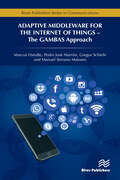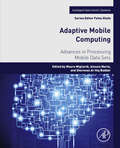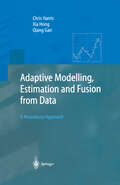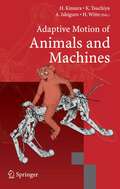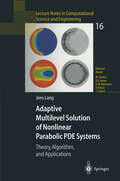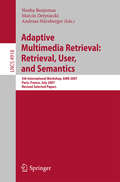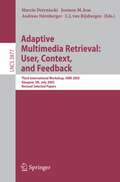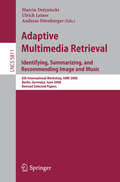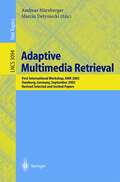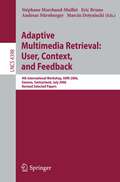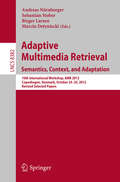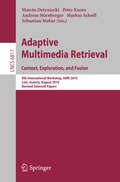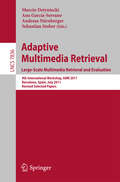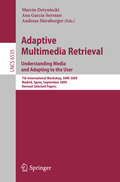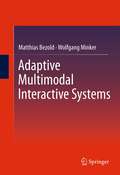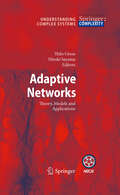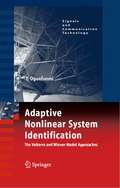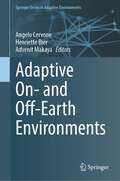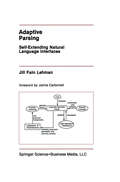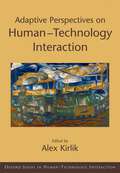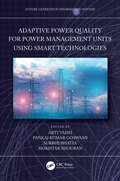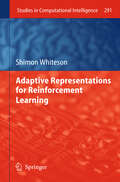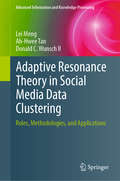- Table View
- List View
Adaptive Middleware for the Internet of Things: The GAMBAS Approach
by Marcus Handte Pedro José Marrón Gregor Schiele Matoses Manuel SerranoOver the past years, a considerable amount of effort has been devoted, both in industry and academia, towards the development of basic technology as well as innovative applications for the Internet of Things. Adaptive Middleware for the Internet of Things introduces a scalable, interoperable and privacy-preserving approach to realize IoT applications and discusses abstractions and mechanisms at the middleware level that simplify the realization of services that can adapt autonomously to the behavior of their users. Technical topics discussed in the book include:Behavior-driven Autonomous ServicesGAMBAS Middleware ArchitectureGeneric and Efficient Data AcquisitionInteroperable and Scalable Data ProcessingAutomated Privacy PreservationAdaptive Middleware for the Internet of Things summarizes the results of the GAMBAS research project funded by the European Commission under Framework Programme 7. It provides an in-depth description of the middleware system developed by the project consortium. In addition, the book describes several innovative mobility and monitoring applications that have been built, deployed and operated to evaluate the middleware under realistic conditions with a large number of users. Adaptive Middleware for the Internet of Things is ideal for personnel in the computer and communication industries as well as academic staff and research students in computer science interested in the development of systems and applications for the Internet of Things.
Adaptive Mobile Computing: Advances in Processing Mobile Data Sets (Intelligent Data-Centric Systems: Sensor Collected Intelligence)
by Mauro Migliardi Alessio Merlo Sherenaz Al-Haj BaddarAdaptive Mobile Computing: Advances in Processing Mobile Data Sets explores the latest advancements in producing, processing and securing mobile data sets. The book provides the elements needed to deepen understanding of this trend which, over the last decade, has seen exponential growth in the number and capabilities of mobile devices. The pervasiveness, sensing capabilities and computational power of mobile devices have turned them into a fundamental instrument in everyday life for a large part of the human population. This fact makes mobile devices an incredibly rich source of data about the dynamics of human behavior, a pervasive wireless sensors network with substantial computational power and an extremely appealing target for a new generation of threats.Offers a coherent and realistic image of today’s architectures, techniques, protocols, components, orchestration, choreography and development related to mobile computingExplains state-of-the-art technological solutions for the main issues hindering the development of next-generation pervasive systems including: supporting components for collecting data intelligently, handling resource and data management, accounting for fault tolerance, security, monitoring and control, addressing the relation with the Internet of Things and Big Data and depicting applications for pervasive context-aware processingPresents the benefits of mobile computing and the development process of scientific and commercial applications and platforms to support themFamiliarizes readers with the concepts and technologies that are successfully used in the implementation of pervasive/ubiquitous systems
Adaptive Modelling, Estimation and Fusion from Data: A Neurofuzzy Approach (Advanced Information Processing)
by Chris Harris Xia Hong Qiang GanThis book brings together for the first time the complete theory of data based neurofuzzy modelling and the linguistic attributes of fuzzy logic in a single cohesive mathematical framework. After introducing the basic theory of data based modelling new concepts including extended additive and multiplicative submodels are developed. All of these algorithms are illustrated with benchmark examples to demonstrate their efficiency. The book aims at researchers and advanced professionals in time series modelling, empirical data modelling, knowledge discovery, data mining and data fusion.
Adaptive Motion of Animals and Machines
by Hiroshi Kimura Kazuo Tsuchiya Akio Ishiguro Hartmut Witt• Motivation It is our dream to understand the principles of animals’ remarkable ability for adaptive motion and to transfer such abilities to a robot. Up to now, mechanisms for generation and control of stereotyped motions and adaptive motions in well-known simple environments have been formulated to some extentandsuccessfullyappliedtorobots.However,principlesofadaptationto variousenvironmentshavenotyetbeenclari?ed,andautonomousadaptation remains unsolved as a seriously di?cult problem in robotics. Apparently, the ability of animals and robots to adapt in a real world cannot be explained or realized by one single function in a control system and mechanism. That is, adaptation in motion is induced at every level from thecentralnervoussystemtothemusculoskeletalsystem.Thus,weorganized the International Symposium on Adaptive Motion in Animals and Machines(AMAM)forscientistsandengineersconcernedwithadaptation onvariouslevelstobebroughttogethertodiscussprinciplesateachleveland to investigate principles governing total systems. • History AMAM started in Montreal (Canada) in August 2000. It was organized by H. Kimura (Japan), H. Witte (Germany), G. Taga (Japan), and K. Osuka (Japan), who had agreed that having a small symposium on motion control, with people from several ?elds coming together to discuss speci?c issues, was worthwhile. Those four organizing committee members determined the scope of AMAM as follows.
Adaptive Multilevel Solution of Nonlinear Parabolic PDE Systems: Theory, Algorithm, and Applications (Lecture Notes in Computational Science and Engineering #16)
by Jens LangNowadays there is an increasing emphasis on all aspects of adaptively gener ating a grid that evolves with the solution of a PDE. Another challenge is to develop efficient higher-order one-step integration methods which can handle very stiff equations and which allow us to accommodate a spatial grid in each time step without any specific difficulties. In this monograph a combination of both error-controlled grid refinement and one-step methods of Rosenbrock-type is presented. It is my intention to impart the beauty and complexity found in the theoretical investigation of the adaptive algorithm proposed here, in its realization and in solving non-trivial complex problems. I hope that this method will find many more interesting applications. Berlin-Dahlem, May 2000 Jens Lang Acknowledgements I have looked forward to writing this section since it is a pleasure for me to thank all friends who made this work possible and provided valuable input. I would like to express my gratitude to Peter Deuflhard for giving me the oppor tunity to work in the field of Scientific Computing. I have benefited immensly from his help to get the right perspectives, and from his continuous encourage ment and support over several years. He certainly will forgive me the use of Rosenbrock methods rather than extrapolation methods to integrate in time.
Adaptive Multimedia Retrieval: 5th International Workshop, AMR 2007, Paris, France, July 5-6, 2007, Revised Selected Papers (Lecture Notes in Computer Science #4918)
by Nozha Boujemaa Marcin Detyniecki Andreas NürnbergerThis book constitutes the thoroughly refereed post-workshop proceedings of the 5th International Workshop on Adaptive Multimedia Retrieval, AMR 2007, held in Paris, France, in July 2007. The 18 revised full papers presented together with 2 invited papers were carefully selected during two rounds of reviewing and improvement. The papers are organized in topical sections on image annotation, feedback and user modelling, music retrieval, fusion, P2P and middleware, databases and summarization, as well as ontology and semantics.
Adaptive Multimedia Retrieval: Third International Workshop, AMR 2005, Glasgow, UK, July 28-29, 2005, Revised Selected Papers (Lecture Notes in Computer Science #3877)
by Marcin Detyniecki Joemon M. Jose Andreas Nürnberger C. J. Van RijsbergenThis book constitutes the thoroughly refereed post-proceedings of the Third International Workshop on Adaptive Multimedia Retrieval, held in September 2005. The 18 revised full papers presented were carefully selected during two rounds of reviewing and improvement. Also included are three invited papers by leading researchers in the area to illustrate the core topics of the workshop: User, Context and Feedback. The papers are organized in topical sections on ranking, systems, spatio-temporal relations, using feedback, using context, and meta data.
Adaptive Multimedia Retrieval: 6th International Workshop, AMR 2008, Berlin, Germany, June 26-27, 2008. Revised Selected Papers (Lecture Notes in Computer Science #5811)
by Marcin Detyniecki Ulrich Leiner Andreas NürnbergerAdaptive Multimedia Retrieval: First International Workshop, AMR 2003, Hamburg, Germany, September 15-16, 2003, Revised Selected and Invited Papers (Lecture Notes in Computer Science #3094)
by Andreas Nürnberger Marcin DetynieckiThis book is an extended collection of contributions that wereoriginally subm- ted to the 1st International Workshop on Adaptive Multimedia Retrieval (AMR 2003), which was organized as part of the 26th German Conference on Arti?cial Intelligence (KI 2003),and held during September 15–18,2003at the University of Hamburg, Germany. Motivated by the overall success of the workshop – as revealed by the stimulating atmosphere during the workshop and the number of very interested and active participants – we ?nally decided to edit a book based on revised papers that were initially submitted to the workshop. Furthermore, we invited some more introductory contributions in order to be able to provide a conclusive book on current topics in the area of adaptive multimedia retrieval systems. We hope that we were able to put together a stimulating collection of articles for the interested reader. We like to thank the organizationcommittee of the 26th German Conference on Arti?cial Intelligence (KI 2003) for providing the setting and the admin- trative support in realizing this workshop as part of their program. Especially, we like to thank Christopher Habel for promoting the workshop as part of the conference program and Andreas Gun ¨ ther for his kind support throughout the organization process.
Adaptive Multimedia Retrieval: 4th International Workshop, AMR 2006, Geneva, Switzerland, July, 27-28, 2006, Revised Selected Papers (Lecture Notes in Computer Science #4398)
by Andreas Nürnberger Marcin Detyniecki Stéphane Marchand-Maillet Eric BrunoThis book constitutes the thoroughly refereed post-proceedings of the 4th International Workshop on Adaptive Multimedia Retrieval, AMR 2006, held in Geneva, Switzerland in July 2006. The papers cover ontology-based retrieval and annotation, ranking and similarity measurements, music information retrieval, visual modeling, adaptive retrieval, structuring multimedia, as well as user integration and profiling.
Adaptive Multimedia Retrieval: 10th International Workshop, AMR 2012, Copenhagen, Denmark, October 24-25, 2012, Revised Selected Papers (Lecture Notes in Computer Science #8382)
by Andreas Nürnberger Sebastian Stober Birger Larsen Marcin DetynieckiThis book constitutes the thoroughly refereed post-conference proceedings of the 10th International Conference on Adaptive Multimedia Retrieval, AMR 2012, held in Copenhagen, Denmark, in October 2012.The 17 revised full papers presented were carefully reviewed and selected from numerous submissions. The papers cover topics of state of the art contributions, features and classification, location context, language and semantics, music retrieval, and adaption and HCI.
Adaptive Multimedia Retrieval. Context, Exploration and Fusion: 8th International Workshop, AMR 2010, Linz, Austria, August 17-18, 2010. Revised Selected Papers (Lecture Notes in Computer Science #6817)
by Marcin Detyniecki Peter Knees Andreas Nürnberger Markus Schedl Sebastian StoberThis book constitutes the refereed proceedings of the 8th International Conference on Adaptive Multimedia Retrieval, AMR 2010, held in Linz, Austria, in August 2010. The 14 revised full papers and the invited contribution presented were carefully reviewed and selected from numerous submissions. The papers are organized in topical sections on Context-based personalization; media information fusion; video retrieval; audio and music retrieval; adaptive similarities; and finding and organizing.
Adaptive Multimedia Retrieval. Large-Scale Multimedia Retrieval and Evaluation: 9th International Workshop, AMR 2011, Barcelona, Spain, July 18-19, 2011, Revised Selected Papers (Lecture Notes in Computer Science #7836)
by Marcin Detyniecki Ana García-Serrano Andreas Nürnberger Sebastian StoberThis book constitutes the refereed post-proceedings of the 9th International Conference on Adaptive Multimedia Retrieval, AMR 2011, held in Barcelona, Spain, in July 2011. The 9 revised full papers and the invited contribution presented were carefully reviewed and selected from numerous submissions. The papers cover topics ranging from theoretical work to practical implementations and its evaluation, most of them dealing with audio or music media. They are organized in topical sections on evaluation and user studies, audio and music, image retrieval, and similarity and music.
Adaptive Multimedia Retrieval. Understanding Media and Adapting to the User: 7th International Workshop, AMR 2009, Madrid, Spain, September 24-25, 2009, Revised Selected Papers (Lecture Notes in Computer Science #6535)
by Marcin Detyniecki Ana García-Serrano Andreas NürnbergerThis book constitutes the refereed proceedings of the 7th International Conference on Adaptive Multimedia Retrieval, AMR 2009, held in Madrid, Spain, in September 2009. The 12 revised full papers and the invited contribution presented were carefully reviewed. The papers are organized in topical sections on grasping multimedia streams; pinpointing music; adapting distances; understanding images; and around the user.
Adaptive Multimodal Interactive Systems
by Matthias Bezold Wolfgang MinkerAdaptive Multimodal Interactive Systems introduces a general framework for adapting multimodal interactive systems and comprises a detailed discussion of each of the steps required for adaptation. This book also investigates how interactive systems may be improved in terms of usability and user friendliness while describing the exhaustive user tests employed to evaluate the presented approaches. After introducing general theory, a generic approach for user modeling in interactive systems is presented, ranging from an observation of basic events to a description of higher-level user behavior. Adaptations are presented as a set of patterns similar to those known from software or usability engineering.These patterns describe recurring problems and present proven solutions. The authors include a discussion on when and how to employ patterns and provide guidance to the system designer who wants to add adaptivity to interactive systems. In addition to these patterns, the book introduces an adaptation framework, which exhibits an abstraction layer using Semantic Web technology.Adaptations are implemented on top of this abstraction layer by creating a semantic representation of the adaptation patterns. The patterns cover both graphical interfaces as well as speech-based and multimodal interactive systems.
Adaptive Networks: Theory, Models and Applications (Understanding Complex Systems)
by Thilo Gross Hiroki SayamaAdding one and one makes two, usually. But sometimes things add up to more than the sum of their parts. This observation, now frequently expressed in the maxim “more is different”, is one of the characteristic features of complex systems and, in particular, complex networks. Along with their ubiquity in real world systems, the ability of networks to exhibit emergent dynamics, once they reach a certain size, has rendered them highly attractive targets for research. The resulting network hype has made the word “network” one of the most in uential buzzwords seen in almost every corner of science, from physics and biology to economy and social sciences. The theme of “more is different” appears in a different way in the present v- ume, from the viewpoint of what we call “adaptive networks.” Adaptive networks uniquely combine dynamics on a network with dynamical adaptive changes of the underlying network topology, and thus they link classes of mechanisms that were previously studied in isolation. Here adding one and one certainly does not make two, but gives rise to a number of new phenomena, including highly robust se- organization of topology and dynamics and other remarkably rich dynamical beh- iors.
Adaptive Nonlinear System Identification: The Volterra and Wiener Model Approaches (Signals and Communication Technology)
by Tokunbo OgunfunmiFocuses on System Identification applications of the adaptive methods presented. but which can also be applied to other applications of adaptive nonlinear processes. Covers recent research results in the area of adaptive nonlinear system identification from the authors and other researchers in the field.
Adaptive On- and Off-Earth Environments (Springer Series in Adaptive Environments)
by Angelo Cervone Henriette Bier Advenit MakayaThis volume investigates the challenges and opportunities for designing, manufacturing and operating off-Earth infrastructures in order to establish adaptive human habitats. The adaptive aspects are considered with respect to the development of adequate infrastructures designed to support human activities. Given the limitations in bringing materials from Earth, utilisation of in-situ resources is crucial for establishing and maintaining these infrastructures.Adaptive on-and off-Earth Environments focuses, among other aspects, on the design, production, and operation processes required to build and maintain such off-Earth infrastructures, while heavily relying on In-Situ Resource Utilisation (ISRU). Such design, production, and operation processes integrate cyber-physical approaches developed and tested on Earth. The challenge is to adapt on-Earth approaches to off-Earth applications aiming at technology advancement and ultimately transfer from on- to off-Earth research. Thischallenge is addressed with contributions from various disciplines ranging from power generation to architecture, construction, and materials engineering involving ISRU for manufacturing processes. All chapters, related to these disciplines, are structured with an emphasis on computing and adaptivity of on-Earth technology to off-Earth applications and vice versa to serve society at large.
Adaptive Parsing: Self-Extending Natural Language Interfaces (The Springer International Series in Engineering and Computer Science #161)
by Jill Fain LehmanAs the computer gradually automates human-oriented tasks in multiple environ ments, the interface between computers and the ever-wider population of human users assumes progressively increasing importance. In the office environment, for instance, clerical tasks such as document filing and retrieval, and higher-level tasks such as scheduling meetings, planning trip itineraries, and producing documents for publication, are being partially or totally automated. The range of users for office oriented software includes clerks, secretaries, and businesspersons, none of whom are predominantly computer literate. The same phenomenon is echoed in the factory production line, in the securities trading floor, in government agencies, in educa tional institutions, and even in the home. The arcane command languages of yes teryear have proven too high a barrier for smooth acceptance of computerized func tions into the workplace, no matter how useful these functions may be. Computer naive users simply do not take the time to learn intimidating and complex computer interfaces. In order to place the functionality of modem computers at the disposition of diverse user populations, a number of different approaches have been tried, many meeting with a significant measure of success, to wit: special courses to train users in the simpler command languages (such as MS-DOS), designing point-and-click menu/graphics interfaces that require much less user familiarization (illustrated most clearly in the Apple Macintosh), and interacting with the user in his or her language of choice.
Adaptive Perspectives on Human-Technology Interaction: Methods and Models for Cognitive Engineering and Human-Computer Interaction (Human Technology Interaction Series)
by Alex KirlikIn everyday life, and particularly in the modern workplace, information technology and automation increasingly mediate, augment, and sometimes even interfere with how humans interact with their environment. How to understand and support cognition in human-technology interaction is both a practically and socially relevant problem. The chapters in this volume frame this problem in adaptive terms: How are behavior and cognition adapted, or perhaps ill-adapted, to the demands and opportunities of an environment where interaction is mediated by tools and technology? The authors draw heavily on the work of Egon Brunswik, a pioneer in ecological and cognitive psychology, as well as on modern refinements and extensions of Brunswikian ideas, including Hammond's Social Judgment Theory, Gigerenzer's Ecological Rationality and Anderson's Rational Analysis. Inspired by Brunswik's view of cognition as "coming to terms" with the "casual texture" of the external world, the chapters in this volume provide quantitative and computational models and measures for studying how people come to terms with an increasingly technological ecology, and provide insights for supporting cognition and performance through design, training, and other interventions. The methods, models, and measures presented in this book provide timely and important resources for addressing problems in the rapidly growing field of human-technology interaction. The book will be of interest to researchers, students, and practitioners in human factors, cognitive engineering, human-computer interaction, judgment and decision making, and cognitive science.
Adaptive Perspectives on Human-Technology Interaction: Methods and Models for Cognitive Engineering and Human-Computer Interaction (Human Technology Interaction Series)
by Alex KirlikIn everyday life, and particularly in the modern workplace, information technology and automation increasingly mediate, augment, and sometimes even interfere with how humans interact with their environment. How to understand and support cognition in human-technology interaction is both a practically and socially relevant problem. The chapters in this volume frame this problem in adaptive terms: How are behavior and cognition adapted, or perhaps ill-adapted, to the demands and opportunities of an environment where interaction is mediated by tools and technology? The authors draw heavily on the work of Egon Brunswik, a pioneer in ecological and cognitive psychology, as well as on modern refinements and extensions of Brunswikian ideas, including Hammond's Social Judgment Theory, Gigerenzer's Ecological Rationality and Anderson's Rational Analysis. Inspired by Brunswik's view of cognition as "coming to terms" with the "casual texture" of the external world, the chapters in this volume provide quantitative and computational models and measures for studying how people come to terms with an increasingly technological ecology, and provide insights for supporting cognition and performance through design, training, and other interventions. The methods, models, and measures presented in this book provide timely and important resources for addressing problems in the rapidly growing field of human-technology interaction. The book will be of interest to researchers, students, and practitioners in human factors, cognitive engineering, human-computer interaction, judgment and decision making, and cognitive science.
Adaptive Power Quality for Power Management Units using Smart Technologies (Future Generation Information Systems)
by Arti Vaish Pankaj Kumar Goswami Surbhi Bhatia Mokhtar ShouranThis book covers issues associated with smart systems due to the presence of onboard nonlinear components. It discusses the advanced architecture of smart systems for power management units. It explores issues of power management and identifies hazardous signals in the power management units of smart devices. It Presents adaptive artificial intelligence and machine learning-based control strategies. Discusses advanced simulations and data synthesis for various power management issues. Showcases solutions to the uncertainty and reliability issues in power management units. Identifies new power quality challenges in smart devices. Explains hybrid active power filters, shunt hybrid active power filters, and the industrial internet of things in power quality management. This book comprehensively discusses advancements of traditional electrical grids, the benefits of smart grids to customers and stakeholders, properties of smart grids, smart grid architecture, smart grid communication, and smart grid security. It further covers the architecture of advance power management units (PMU) of smart devices, and the identification of harmonic distortions with respect to various sensor-based technology. It will serve as an ideal reference text for senior undergraduate and graduate students, and academic researchers in fields including electrical engineering, electronics, communications engineering, and computer engineering.
Adaptive Power Quality for Power Management Units using Smart Technologies (Future Generation Information Systems)
by Arti Vaish Pankaj Kumar Goswami Surbhi Bhatia Mokhtar ShouranThis book covers issues associated with smart systems due to the presence of onboard nonlinear components. It discusses the advanced architecture of smart systems for power management units. It explores issues of power management and identifies hazardous signals in the power management units of smart devices. It Presents adaptive artificial intelligence and machine learning-based control strategies. Discusses advanced simulations and data synthesis for various power management issues. Showcases solutions to the uncertainty and reliability issues in power management units. Identifies new power quality challenges in smart devices. Explains hybrid active power filters, shunt hybrid active power filters, and the industrial internet of things in power quality management. This book comprehensively discusses advancements of traditional electrical grids, the benefits of smart grids to customers and stakeholders, properties of smart grids, smart grid architecture, smart grid communication, and smart grid security. It further covers the architecture of advance power management units (PMU) of smart devices, and the identification of harmonic distortions with respect to various sensor-based technology. It will serve as an ideal reference text for senior undergraduate and graduate students, and academic researchers in fields including electrical engineering, electronics, communications engineering, and computer engineering.
Adaptive Representations for Reinforcement Learning (Studies in Computational Intelligence #291)
by Shimon WhitesonThis book presents new algorithms for reinforcement learning, a form of machine learning in which an autonomous agent seeks a control policy for a sequential decision task. Since current methods typically rely on manually designed solution representations, agents that automatically adapt their own representations have the potential to dramatically improve performance. This book introduces two novel approaches for automatically discovering high-performing representations. The first approach synthesizes temporal difference methods, the traditional approach to reinforcement learning, with evolutionary methods, which can learn representations for a broad class of optimization problems. This synthesis is accomplished by customizing evolutionary methods to the on-line nature of reinforcement learning and using them to evolve representations for value function approximators. The second approach automatically learns representations based on piecewise-constant approximations of value functions. It begins with coarse representations and gradually refines them during learning, analyzing the current policy and value function to deduce the best refinements. This book also introduces a novel method for devising input representations. This method addresses the feature selection problem by extending an algorithm that evolves the topology and weights of neural networks such that it evolves their inputs too. In addition to introducing these new methods, this book presents extensive empirical results in multiple domains demonstrating that these techniques can substantially improve performance over methods with manual representations.
Adaptive Resonance Theory in Social Media Data Clustering: Roles, Methodologies, and Applications (Advanced Information and Knowledge Processing)
by Lei Meng Ah-Hwee Tan Donald C. Wunsch IISocial media data contains our communication and online sharing, mirroring our daily life. This book looks at how we can use and what we can discover from such big data:Basic knowledge (data & challenges) on social media analyticsClustering as a fundamental technique for unsupervised knowledge discovery and data miningA class of neural inspired algorithms, based on adaptive resonance theory (ART), tackling challenges in big social media data clustering Step-by-step practices of developing unsupervised machine learning algorithms for real-world applications in social media domainAdaptive Resonance Theory in Social Media Data Clustering stands on the fundamental breakthrough in cognitive and neural theory, i.e. adaptive resonance theory, which simulates how a brain processes information to perform memory, learning, recognition, and prediction.It presents initiatives on the mathematical demonstration of ART’s learning mechanisms in clustering, and illustrates how to extend the base ART model to handle the complexity and characteristics of social media data and perform associative analytical tasks.Both cutting-edge research and real-world practices on machine learning and social media analytics are included in the book and if you wish to learn the answers to the following questions, this book is for you:How to process big streams of multimedia data?How to analyze social networks with heterogeneous data?How to understand a user’s interests by learning from online posts and behaviors?How to create a personalized search engine by automatically indexing and searching multimodal information resources? .
